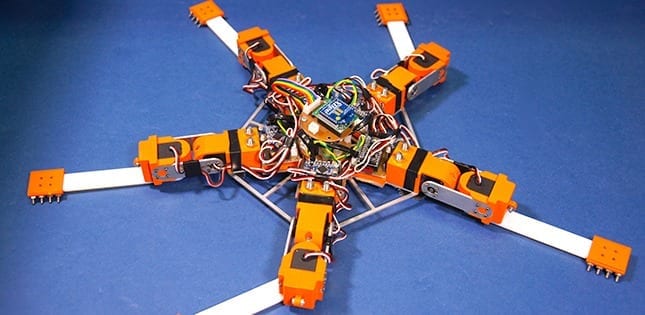
Robots created by a team working at the University of California, Santa Barbara are able to look through solid walls using just Wi-Fi signals.
With potential applications in search and rescue, surveillance, detection and archeology, these robots have the capability to identify the position and outline of unseen objects within a scanned structure, and then categorize their composition as metal, timber, or flesh.
Working in pairs, the robots traverse the perimeter of an object or structure and alternately transmit and receive Wi-Fi radio signals between each other through the object being scanned. Exploiting the differences in transmitted and received Wi-Fi signal strengths to show the presence of hidden objects, the system uses a wave-propagation model with a target resolution of around 2 cm (0.8 in). By measuring the received field strengths of these wireless transmissions, the robots are able to produce an accurate map of the structure detailing where solid objects and spaces are located.
Though these aren’t the first robots that have been claimed to be able to see through concrete – the Cougar20-H surveillance robot achieved that some years ago – other systems have relied on a number of GHz-range, high-power radio sensor arrays that were essentially complex radar systems. Similarly, a fixed Wi-Fi system created by MIT was able to detect movement behind walls using Wi-Fi as its transmitter and receiver, but the resolution was too low to do more than detect movement, let alone categorize and identify objects.
The UCSB robots, however, rely solely on interpretations of Wi-Fi radio transmissions which – even though they are still of both lower strength and much lower dynamic range than higher-powered arrays – indicates that the signal processing and post-capture computation must be key to their “X-ray vision” capabilities. This is borne out in the team’s assertions that they use wavelet, total variation, and spatial domain filters and computations in their receiving equipment and processing computers, and the use of a SLAM algorithm in their on-the-fly mapping computations.
The Latest on: Robots that use Wi-Fi to see through walls
[google_news title=”” keyword=”Robots that use Wi-Fi to see through walls” num_posts=”10″ blurb_length=”0″ show_thumb=”left”]
via Google News
The Latest on: Robots that use Wi-Fi to see through walls
- A spider-inspired robot designed for exploring space caveson May 10, 2024 at 2:44 pm
Stanford University engineers have created a spider-like robot for the exploration of caves or lava tubes on Mars. The midsized robot is reportedly capable of exploring areas — namely caves or lava ...
- How we test robot vacuums and mops at TechHiveon May 9, 2024 at 11:12 pm
The robot vacuum market is booming, with more innovative and diverse models hitting the shelves every week. These household helpers are becoming increasingly sophisticated, with features ranging from ...
- The week's best robot vacuum deals: Roomba and Eufyon May 9, 2024 at 10:00 am
If you buy something through links on our site ... Look for app control: WiFi-enabled robot vacuums can be synced with a smartphone app to control scheduling, manual start, and cleaning settings ...
- Penguin-inspired robot explores sea using AIon May 8, 2024 at 3:00 am
Quadroin AUV is an underwater research robot that mimics penguins' graceful and swift swimming, descending to depths of 492 feet at speeds up to 11.5 mph.
- Scientists create robot snails that can move independently using tracks or work together to climbon May 7, 2024 at 6:00 am
A team of roboticists at the Chinese University of Hong Kong has created a robot snail with a helmet-like shell that moves by rolling around on bulldozer-like tracks. They have published a paper on ...
- Best Roomba deals: Top robot vacuums from as little as $160on May 7, 2024 at 5:02 am
If you picture robot ... It’s Wi-Fi connected and can be controlled by Google, plus it has all the mapping features that will keep it from constantly bumping into your walls and your furniture.
- Random robots are more reliableon May 2, 2024 at 2:02 am
Northwestern University engineers have developed a new artificial intelligence (AI) algorithm designed specifically for smart robotics. By helping robots rapidly and reliably learn complex skills ...
- Humanoid robots are learning to fall wellon April 28, 2024 at 1:15 pm
It’s the sort of thing I would like to see more from ... Protect your head Use your weight to direct your fall Bend your knees Avoid taking other people with you As for robots, this IEEE ...
- The best robot vacuums for every budgeton April 25, 2024 at 2:00 am
All products featured here are independently selected by our editors and writers. If you buy something through links on our site, Mashable may earn an affiliate commission. UPDATE: Apr. 25, 2024 ...
- Your Wireless Earbuds Are Trash (Eventually)on April 24, 2024 at 10:35 am
When you buy through our links ... I struggle with this information. I love using wireless earbuds, and I recommend them to people every day. But I also want to be a responsible global citizen.
via Bing News










